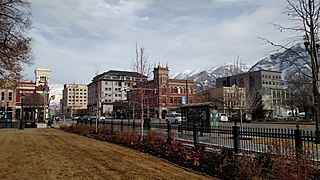
Provo is a city in and the county seat of Utah County, Utah, United States. It is 43 miles (69 km) south of Salt Lake City along the Wasatch Front, and lies between the cities of Orem to the north and Springville to the south. With a population at the 2020 census of 115,162, Provo is the fourth-largest city in Utah and the principal city in the Provo-Orem metropolitan area, which had a population of 526,810 at the 2010 census. It is Utah's second-largest metropolitan area after Salt Lake City.

Payson is a city in Utah County, Utah, United States. It is part of the Provo–Orem Metropolitan Statistical Area. The population was 21,101 at the 2020 census.
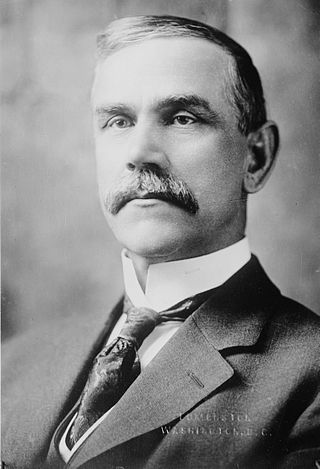
Reed Smoot was an American politician, businessman, and apostle of the Church of Jesus Christ of Latter-day Saints. A Republican who was first elected to the U.S. Senate by the Utah State Legislature in 1902, he served from 1903 to 1933. Smoot is primarily remembered as the co-sponsor of the 1930 Smoot–Hawley Tariff Act, which increased almost 900 American import duties. Criticized at the time as having "intensified nationalism all over the world" by Thomas Lamont of J.P. Morgan & Co., Smoot–Hawley is widely regarded as one of the catalysts for the worsening Great Depression.
William Harrison Folsom was an architect and contractor. He constructed many of the historic buildings in Utah, particularly in Salt Lake City. Many of his most prominent works were commissioned by the Church of Jesus Christ of Latter-day Saints. For a time he was sustained as the Church Architect, a calling in the church.

Maeser Elementary was an elementary school in Provo, Utah. It was named after Karl G. Maeser. Built in 1898, it is the oldest school building in Provo, Utah. The school was designed by architect Richard C. Watkins, who also designed the Provo Third Ward Chapel and Amusement Hall, The Knight Block Building, and the Thomas N. Taylor Mansion.

Titus Billings was an early convert to the Latter Day Saint movement. He served in several positions in the church and was a contemporary of Joseph Smith and Brigham Young. Billings was a counselor in the first Bishopric of the Church to Edward Partridge. He participated in the Battle of Crooked River and was a colonel in the Nauvoo Legion. He participated in the Mormon migration as a Captain of Fifty in the second company and was a notable settler of Manti, Utah.
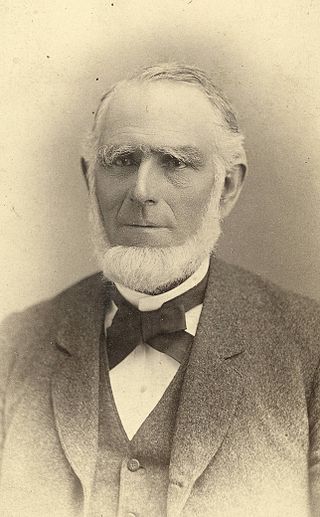
Abraham Owen Smoot was an American pioneer, businessman, religious leader, and politician. He spent his early life in the Southern United States and was one of seven children. After being baptized a member of the Church of Christ, predecessor to the Church of Jesus Christ of Latter-day Saints, Smoot served as a missionary in Kentucky, Tennessee, South Carolina, and England. He received no formal education, but learned to read as a child and later attended the School of the Prophets in Kirtland, Ohio. Like other early members of the LDS Church, Smoot practiced plural marriage, eventually marrying six women and having 24 children. After migrating west to Utah Territory, he was elected as the second mayor of Salt Lake City and maintained this position from 1857 to 1866. He was then assigned by Brigham Young to move to Provo, where he served as stake president and mayor from 1868 to 1881. He assisted financially in the construction of the Provo Tabernacle—today the Provo City Center Temple—as well as that of the Utah Southern Railroad. Smoot was the first president of the board of trustees of Brigham Young Academy (BYA)—which later developed into Brigham Young University (BYU). He was an early financial supporter of the institution and was nicknamed the "foster father" of the academy. His goal was to make education available to young Latter-day Saints. Today, the Smoot Administration Building at BYU is named after him.
The Smoot–Rowlett family is a U.S. political family. It is linked by marriage to the Kimball–Snow–Woolley family.
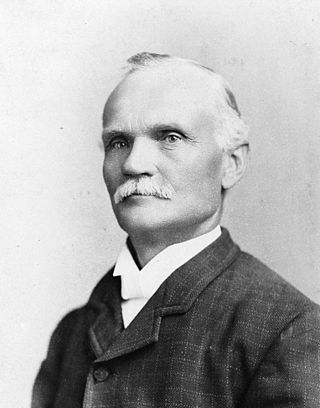
Karl Gottfried Maeser was a prominent Utah educator and a member of the Church of Jesus Christ of Latter-day Saints. He served 16 years as principal of Brigham Young Academy. Although he was not the first principal of the Academy, he is considered its founder. The Academy later became Brigham Young University (BYU) in 1903.
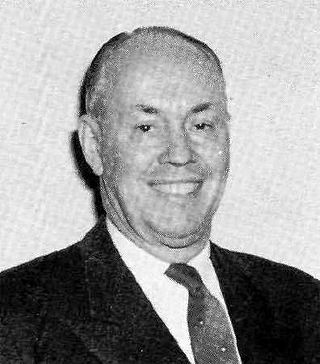
Carl William Buehner was a German-American politician who was general authority of the Church of Jesus Christ of Latter-day Saints from 1952 to 1961 and was the Republican Party candidate for governor of Utah in the 1968 election.
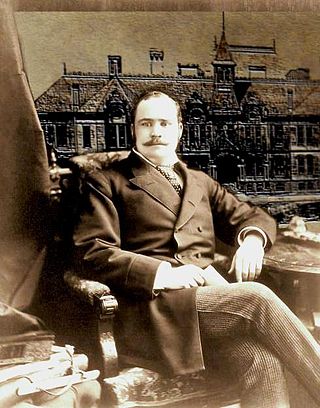
Joseph Don Carlos Young was an American architect and the Church Architect for the Church of Jesus Christ of Latter-day Saints from 1887 until 1893. In 1893, the office of Church Architect was dissolved, Young thereafter practiced privately with the LDS Church as a frequent client. Young practiced as an architect, landscape architect and designer from 1879 to circa 1935. A preponderance of his work centered on church commissions, or commissions offered him by extended Young family members, or higher echelon church friends.
George Wendell Pace was an American professor of religion at Brigham Young University (BYU) in Provo, Utah. He was a popular writer and speaker on religion in The Church of Jesus Christ of Latter-day Saints and part of a public criticism voiced by Apostle Bruce R. McConkie in 1982.
Fred Lewis Markham was an American architect in the early 20th century who designed movie theatres and many buildings on the campus of Brigham Young University (BYU) in Provo, Utah.
Richard Olsen Cowan is a historian of the Church of Jesus Christ of Latter-day Saints and a former professor in the Church History Department of Brigham Young University (BYU). He was one of the longest-serving BYU faculty and the longest-serving member of the Church History Department ever.
Richard Eyring "Rick" Turley Jr. is an American historian and genealogist. He previously served as both an Assistant Church Historian of the Church of Jesus Christ of Latter-day Saints and as managing director of the church's public affairs department.
Paul Robert Cheesman was an American academic and a professor of religion at Brigham Young University (BYU).
Gilbert Woodrow Scharffs was a Latter-day Saint religious educator and author.
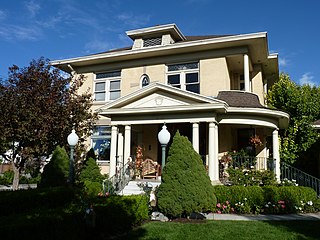
The Thomas N. Taylor House is a historic house located at 342 North 500 West in Provo, Utah. It is listed on the National Register of Historic Places.

Amanda Inez Knight Allen was a Mormon missionary and a Utah politician. In 1898, she became one of the first two single women to be missionaries for the Church of Jesus Christ of Latter-day Saints.
Brent Ferrin Ashworth is an American historical document dealer who specializes in Mormon history. He has assisted the Glenn Beck organization, the LDS Church History Library, Brigham Young University (BYU) Library Special Collections, the Utah Valley University (UVU) Library Special Collections, State History Division, including the Utah State Archives and other major institutions. He has recently assisted Beck with his first three history museums, starting with "Man in the Moon" at the Grand America Hotel in Salt Lake City, over the July 4th holiday in 2013, and the Fiftieth Anniversary of the Kennedy Assassination in conjunction with the Mercury One Convention at the Omni Hotel in Dallas, Texas, in November 2013. Ashworth has donated many books and other items in his collection to the LDS Church and his items have been displayed at the Crandall Historical Printing Museum in Provo, Utah.